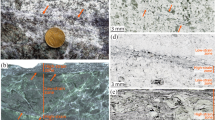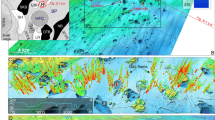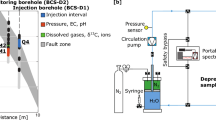Abstract
Carbon capture and geological storage represents a potential means of managing atmospheric carbon dioxide levels. Understanding the role of faults, as either barriers or conduits to the flow of carbon dioxide, is crucial for predicting the long-term integrity of geological storage sites. Of particular concern is the influence of geochemical reactions on the sealing behaviour of faults and the impact of seismicity and stress regime on fault stability. Here, we examine a 135,000-year palaeorecord of carbon dioxide leakage from a faulted, natural carbon dioxide reservoir in Utah. We assess the isotope and trace-element composition of U–Th-dated carbonate veins, deposited by carbon-dioxide-rich fluids. Temporal changes in vein geochemistry reveal pulses of carbon dioxide injection into the reservoir from deeper formations. Surface leakage rates increase by several orders of magnitude following these pulses. We show that each pulse occurs around 100–2,000 years after the onset of significant local climatic warming, at glacial to interglacial transitions. We suggest that carbon dioxide leakage rates increase as a result of fracture opening, potentially caused by changes in groundwater hydrology, the intermittent presence of a buoyant gas cap and postglacial crustal unloading of regions surrounding the fault.
This is a preview of subscription content, access via your institution
Access options
Subscribe to this journal
Receive 12 print issues and online access
$259.00 per year
only $21.58 per issue
Buy this article
- Purchase on Springer Link
- Instant access to full article PDF
Prices may be subject to local taxes which are calculated during checkout




Similar content being viewed by others
References
Hawkes, C. D., Bachu, S. & McLellan, P. J. Geomechanical factors affecting geological storage of CO2 in depleted oil and gas reservoirs. J. Can. Pet. Tech. 44, 52–61 (2005).
Adams, J., Wetmiller, R. J., Hasegawa, H. S. & Drysdale, J. The first surface faulting from a historical intraplate earthquake in North America. Nature 352, 617–619 (1991).
Gilfillan, S. M. et al. The noble gas geochemistry of natural CO2 gas reservoirs from the Colorado plateau and Rocky Mountain provinces, USA. Geochim. Cosmochim. Acta 72, 1174–1198 (2008).
Allis, R. et al. Natural CO2 reservoirs on the Colorado plateau and southern Rocky Mountains: Candidates for CO2 sequestration. Proc. First Natl. Conf. Carbon Sequestration, Washington DC, May 14–17 2001 19 (2001).
Shipton, Z. K. et al. in Geological Storage of Carbon Dioxide (eds Baines, S. J. & Worden, R. H.) 43–58 (Geol. Soc. Lond. Special Publ. 233, 2004).
Assayag, N., Bickle, M., Kampman, N. & Becker, J. Carbon isotopic constraints on CO2 degassing in cold-water geysers, Green River, Utah. Energy Procedia 1, 2361–2366 (2009).
Heath, J. Hydrogeochemical Characterization of Leaking Carbon Dioxide-Charged Fault Zones in East-Central Utah Masters thesis, Utah State Univ. (2004).
Kampman, N., Bickle, M., Becker, J., Assayag, N. & Chapman, H. Feldspar dissolution kinetics and Gibbs free energy dependence in a CO2-enriched groundwater system, Green River, Utah. Earth Planet. Sci. Lett. 284, 473–488 (2009).
Wilkinson, M., Gilfillan, S. V. M., Haszeldine, R. S. & Ballentine, C. J. in Carbon Dioxide Sequestration in Geological Media—State of the Science Vol. 59 (eds Grobe, M., Pashin, J. C. & Dodge, R. L.) 619–634 (AAPG Studies in Geology, 2009).
Dockrill, B. & Shipton, Z. K. Structural controls on leakage from a natural CO2 geologic storage site: Central Utah, USA. J. Struct. Geol. 32, 1768–1782 (2010).
Uysal, I. T. et al. U-series dating and geochemical tracing of Late Quaternary travertine in co-seismic fissures. Earth Planet. Sci. Lett. 257, 450–462 (2007).
Faccenna, C. et al. Late Pleistocene depositional cycles of the Lapis Tiburtinus travertine (Tivoli, central Italy): Possible influence of climate and fault activity. Glob. Planet. Change 63, 299–308 (2008).
Uysal, I. T. et al. Hydrothermal CO2 degassing in seismically active zones during the Late Quaternary. Chem. Geol. 265, 442–454 (2009).
Barnes, I., Irwin, W. & White, D. Global Distribution of CO 2 and Major Zones of Seismicity. US Geol. Surv. Open-File Rep. 39–78 (1978).
Wiprut, D. & Zoback, M. D. Fault reactivation and fluid flow along a previously dormant normal fault in the northern North Sea. Geology 28, 595–598 (2000).
Burnside, N. U–Th Dating of Travertine on the Colorado Plateau: Implications for the Leakage of Geologically Stored CO 2 PhD thesis, Univ. Glasgow (2010).
Winograd, I. J. et al. Continuous 500,000-year climate record from vein calcite in Devils Hole, Nevada. Science 258, 255–260 (1992).
Jiménez-Moreno, G., Scott Anderson, R. & Fawcett, P. J. Orbital- and millennial-scale vegetation and climate changes of the past 225 ka from Bear Lake, Utah–Idaho (USA). Quat. Sci. Rev. 26, 1713–1724 (2007).
Benson, L. V. et al. The rise and fall of Lake Bonneville between 45 and 10.5 ka. Quat. Int. 235, 57–69 (2011).
Grootes, P. M., Stuiver, M., White, J. W. C., Johnsen, S. & Jouzel, J. Comparison of oxygen isotope records from the GISP2 and GRIP Greenland ice cores. Nature 366, 552–554 (1993).
Kawamura, K. et al. Northern Hemisphere forcing of climatic cycles in Antarctica over the past 360,000 years. Nature 448, 912–916 (2007).
Shakun, J. D., Burns, S. J., Clark, P. U., Cheng, H. & Edwards, R. L. Milankovitch-paced termination II in a Nevada speleothem? Geophys. Res. Lett. 38, L18701 (2011).
Henderson, G. M. & Slowey, N. C. Evidence from U–Th dating against Northern Hemisphere forcing of the penultimate deglaciation. Nature 404, 61–66 (2000).
Cheng, H. et al. Ice age terminations. Science 326, 248–252 (2009).
Gallup, C. D., Cheng, H., Taylor, F. W. & Edwards, R. L. Direct determination of the timing of sea level change during termination II. Science 295, 310–313 (2002).
Drysdale, R. N. et al. Evidence for obliquity forcing of glacial termination II. Science 325, 1527–1531 (2009).
Gaetani, G. A. & Cohen, A. L. Element partitioning during precipitation of aragonite from seawater: A framework for understanding paleoproxies. Geochim. Cosmochim. Acta 70, 4617–4634 (2006).
Spangler, L. E., Naftz, D. L. & Peterman, Z. E. Hydrology, Chemical Quality, and Characterization of Salinity in the Navajo Aquifer in and Near the Greater Aneth Oil Field. San Juan County, Utah US Geol. Surv. Water Resources Investigations Report 96–4155 (USGS, 1996).
Johnson, T. M. & DePaolo, D. J. Interpretation of isotopic data in groundwater-rock systems: Model development and applications to Sr-isotope data from Yucca Mountain. Wat. Resour. Res. 30, 1571–1587 (1994).
Truini, M. & Longsworth, S. Hydrogeology of the D Aquifer and Movement and Ages of Ground Water Determined from Geochemical and Isotopic Analyses, Black Mesa Area, Northeastern Arizona (US Dept. of the Interior, US Geological Survey, 2003).
Zhu, C., Waddell, R. K., Star, I. & Ostrander, M. Responses of ground water in the Black Mesa Basin, northeastern Arizona, to paleoclimatic changes during the late Pleistocene and Holocene. Geology 26, 127–130 (1998).
Wong, I. G. & Humphrey, J. R. Contemporary seismicity, faulting, and the state of stress in the Colorado plateau. Geol. Soc. Am. Bull. 101, 1127–1146 (1989).
Bills, B. G. & May, G. M. Lake Bonneville: Constraints on lithospheric thickness and upper mantle viscosity from isostatic warping of Bonneville, Provo, and Gilbert stage shorelines. J. Geophys. Res. 92, 11493–11508 (1987).
Machette, M. N., Personius, S. F., Nelson, A. R., Schwartz, D. P. & Lund, W. R. The Wasatch Fault zone, Utah segmentation and history of Holocene earthquakes. J. Struct. Geol. 13, 137–149 (1991).
Laabs, B. J. C. et al. Latest Pleistocene glacial chronology of the Uinta Mountains: Support for moisture-driven asynchrony of the last deglaciation. Quat. Sci. Rev. 28, 1171–1187 (2009).
Leonard, E. Modeled patterns of late Pleistocene glacier inception and growth in the southern and central Rocky Mountains, USA: Sensitivity to climate change and paleoclimatic implications. Quat. Sci. Rev. 26, 2152–2166 (2007).
Munroe, J. S. et al. Latest Pleistocene advance of alpine glaciers in the southwestern Uinta Mountains, Utah, USA: Evidence for the influence of local moisture sources. Geology 34, 841–844 (2006).
Pelletier, J. D. Estimate of three-dimensional flexural-isostatic response to unloading: Rock uplift due to late Cenozoic glacial erosion in the western United States. Geology 32, 161–164 (2004).
Hetzel, R. & Hampel, A. Slip rate variations on normal faults during glacial–interglacial changes in surface loads. Nature 435, 81–84 (2005).
Hampel, A., Hetzel, R. & Maniatis, G. Response of faults to climate-driven changes in ice and water volumes on Earth’s surface. Phil. Trans. R. Soc. A 368, 2501–2517 (2010).
Karow, T. & Hampel, A. Slip rate variations on faults in the Basin-and-Range Province caused by regression of late Pleistocene Lake Bonneville and Lake Lahontan. Int. J. Earth Sci. 99, 1941–1953 (2010).
Friedrich, A. M., Wernicke, B. P., Niemi, N. A., Bennett, R. A. & Davis, J. L. Comparison of geodetic and geologic data from the Wasatch region, Utah, and implications for the spectral character of Earth deformation at periods of 10 to 10 million years. J. Geophys. Res. 108, 2199–2222 (2003).
Muir-Wood, R. Deglaciation seismotectonics: A principal influence on intraplate seismogenesis at high latitudes. Quat. Sci. Rev. 19, 1399–1411 (2000).
Malservisi, R., Dixon, T. H., La Femina, P. C. & Furlong, K. P. Holocene slip rate of the Wasatch Fault zone, Utah, from geodetic data: Earthquake cycle effects. Geophys. Res. Lett. 30, 1673–1677 (2003).
Kerrick, D. M. Present and past nonanthropogenic CO2 degassing from the solid Earth. Rev. Geophys. 39, 565–585 (2001).
Ellam, R. M. & Keefe, K. MC-ICP-MS analysis of non-natural U isotope ratios using a 229Th/232Th external mass bias correction. J. Anal. At. Spectrom. 22, 147–152 (2007).
Beck, W. C., Grossman, E. L. & Morse, J. W. Experimental studies of oxygen isotope fractionation in the carbonic acid system at 15°, 25°, and 40 °C. Geochim. Cosmochim. Acta 69, 3493–3503 (2005).
Romanek, C. S., Grossman, E. L. & Morse, J. W. Carbon isotopic fractionation in synethic aragonite and calcite—effects of temperature and precipiaiton rate. Geochim. Cosmochim. Acta 56, 419–430 (1992).
Zhou, G. T. & Zheng, Y. F. An experimental study of oxygen isotope fractionation between inorganically precipitated aragonite and water at low temperatures. Geochim. Cosmochim. Acta 67, 387–399 (2003).
Acknowledgements
Carbon-storage research at Cambridge is supported by the Natural Environment Research Council grant NE/F004699/1. This research was made possible by financial support for N.K. from Shell Global Solutions International. N.M.B. was supported by NER/S/A/2006/14354. N.K. would like to thank M. Hall in the Godwin Laboratories, Cambridge, for assistance with stable isotope analysis.
Author information
Authors and Affiliations
Contributions
This work was conceived by N.K. and M.J.B. U–Th dating was carried out by N.M.B. at the Scottish Universities Environmental Research Centre, with support from Z.K.S. and R.M.E. Stable isotope analyses were carried out in the Godwin Laboratory, Cambridge. Trace-element analyses were carried out by N.K. and H.J.C. and N.K. carried out the Sr-isotope analyses. N.K. wrote the initial draft and M.J.B. and J.A.N. contributed to revisions.
Corresponding author
Ethics declarations
Competing interests
The authors declare no competing financial interests.
Supplementary information
Supplementary Information
Supplementary Information (PDF 1125 kb)
Supplementary Information
Supplementary Information (XLS 16 kb)
Supplementary Information
Supplementary Information (XLS 13 kb)
Rights and permissions
About this article
Cite this article
Kampman, N., Burnside, N., Shipton, Z. et al. Pulses of carbon dioxide emissions from intracrustal faults following climatic warming. Nature Geosci 5, 352–358 (2012). https://doi.org/10.1038/ngeo1451
Received:
Accepted:
Published:
Issue Date:
DOI: https://doi.org/10.1038/ngeo1451
This article is cited by
-
Characteristics of bleaching around major structures in a reservoir-cap rock system, SE Utah, USA
Arabian Journal of Geosciences (2020)
-
420,000 year assessment of fault leakage rates shows geological carbon storage is secure
Scientific Reports (2019)
-
Observational evidence confirms modelling of the long-term integrity of CO2-reservoir caprocks
Nature Communications (2016)
-
Geologic methane seeps along boundaries of Arctic permafrost thaw and melting glaciers
Nature Geoscience (2012)



